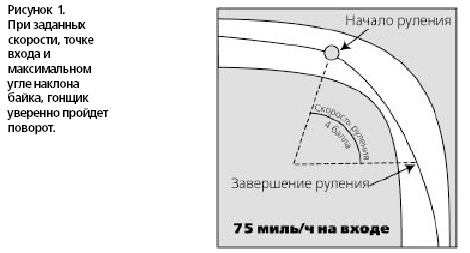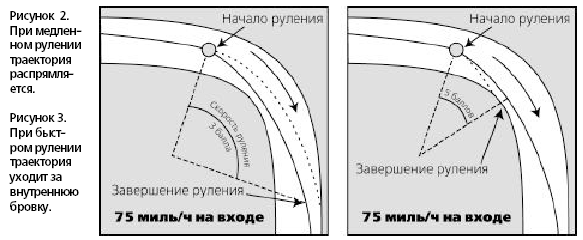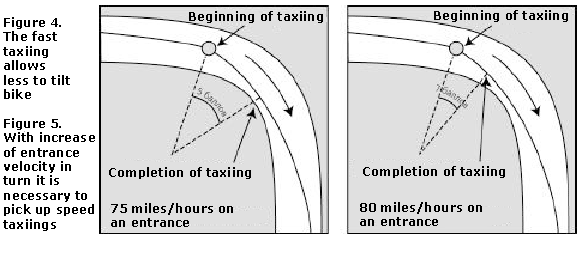|
The Chapter 15. Taxiing - speed of the taxiing
In each turn you spend any time for process of taxiing. What is the time
and how much attentions takes away in you it is the relevant problem?
Whether you know, as far as it is fast do the foremans? Or for them it
receives only because for them at the command of most perfect engineering?
Let's allow, that the speed of taxiing of the foremans estimates in 10
balls. How much then balls you receive? The customary "street" driver enter
turn approximately for 2 seconds. Best do of best it for 0,5 seconds. The
mean racer will receive 3 or 4 balls on a 10-mark scale. How to reduce time
by taxiing and what for it it is necessary? What hinders you to taxi fast?
SPI's and taxiing
Give is recognized one another - to go into turn very terribly. You are
afraid, that the motorcycle out from under you, that, having inclined too
fast, bike will lose coupling with a road. Besides the too abrupt angle of
lean causes to work SPI's. Therefore beginners try to not be tilted too fast
or too hardly.
The credit of a slope
But that is strange - in offensive situations the "street" drivers pass
turn with large angle of lean, than it is necessary at the given speed. And
many racers do same. They as though the credit of a slope. There is
a capability to incline whether or not (step or silencer already cut
scintilla), all of them equally try to choke bike even more. I often saw,
how the racers scratch parts of a motorcycle in turns, which one can be
passed on 5-10 of miles per hour faster and thus with smaller angle of lean.
Than more abruptly corner - the better? Or you will prefer to drive turn
faster with a smaller corner?
The too large corner is an error
At increase of angle of lean the motorcycle becomes less stable.
Than more abruptly corner - the worse. Knolls, pothole, the slippery
sites of a route with the greater probability will put in yaw or drift at
the greater angle of lean. Besides the more abruptly corner of Nalonum, the
be more exact owes control of gas. Certainly cheerfully lowdown a motorcycle
in turn more abruptly. But the fun is prolonged not for long - works SPI and
the situation leaves from under the control. Give is identifiable the
purpose and problem of taxiing.
The purpose of taxiing - to change a current of traffic. A problem of
taxiing precisely to pass turn minimumly possible for the given speed by
angle of lean.
Taxiing, angle of lean and speed
Well-known: than more speed - the more angle of lean. Good, agree. With
growth of speed the centrifugal effort seek to pop you out of turn grows.
Augmenting a corner, you indemnify this force. But it yet all. Let's draw a
normal turn, entry point, pathway and point of achievement of desirable
angle of lean (fig. 1).

Remain constants. As the pathway will change. Certainly, (broken line)
will be straightened.
Let's allow, that in third times our racer taxied faster at constant
other parameters. Where he will appear? Correctly - inside turn (figure 3).

How to him to pass turn in the third case? There are some versions:
- To go into turn later. But whether it is necessary to change a lower
turning point, if available normally works? Is thought, no.
- Earlier to open gas. Not bad, but it is necessary to cause
itself to make it.
- To open gas and directly a pathway more strongly. Probably.
- To open gas and earlier and more strongly. Too it is possible.
- To reduce a corner (figure 4). Why also no!
Only version ¹5 opens more doors, than occludes. For example, if you have
learned to drive turn by smaller angle of lean, to you will be more lighter
in due course to pick up speed in turn, using a reserve of angle of lean.
What if the racer wants to pick up speed transits of turn, at a fixed
datum of an input and constant angle of lean? He should taxi faster.

So, at a preset speed, the faster you turn bike, the the smaller corner
is required for transit of turn. Whether well to drive turn with a smaller
corner? Yes. Whether positively it influences safety? Yes. Whether becomes
bike more stable? Yes. Helps l and it to drive turns faster? Yes. Better
than l and coupling with a road at smaller angle of lean? Yes. Whether
decides it a problem of taxiing? Yes. Well what, has convinced?
Main in turn - not where to turn, and as far as fast to turn. I learn the
students to turn faster. As soon as they perceive, what exactly it gives to
them, they prolong to perfect this skill. DG
|